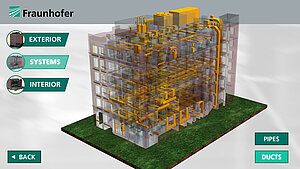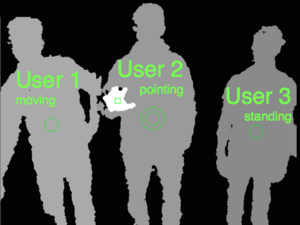Pose and gesture analysis
We research and develop fast and reliable algorithms for detection and tracking of whole body movements as well as movements of specific body parts. Our solutions focus on body, head, eye, hand and finger tracking as well as posture, movement and gait analysis. Our algorithms are based on non-intrusive, marker less sensors which provide 2D and/or 3D video signals, e.g. colour, depth-from stereo, time of flight or structured light. These algorithms are designed to work with a variety of cameras from low cost, mobile to high-end devices finding a best compromise between performance and price, from offline behaviour analysis to real-time human-computer interaction.
Behaviour analysis for human-computer interaction
Based on our detection and tracking algorithms as well as additional novel input sources such as voice control, we create novel human computer interaction modules. This involves calibration, fusion and interpretation of various data in a specific context. These modules are used in various applications such as behaviour analysis for ambient assisted living solutions, interaction with applications and media content as well as novel video communication applications.

Contact-free human-computer interaction
We believe that in the near future traditional computer input devices like keyboard and mouse are going to be supplemented or replaced by more natural interfaces. Applying usability engineering methods and the user centred design approach, we develop novel concepts for contact-free human-computer interaction that allow users to control any application or system by using free-form hand, finger or whole body movements and gestures. If suitable and beneficial, we include additional input technologies such as voice control to improve user experiences in specific scenarios. Applying our interaction modules various solutions in the field of medical, automotive, digital signage, cultural heritage or education have been developed that prove the capability of these interaction concepts.

3D user interfaces
Regarding the enormous potential of virtual environments, the development of appropriate ready-to-use graphical components is the key to successfully make 3D multimedia contents accessible to a large public. We have a long experience in designing novel graphical interfaces and adding navigation metaphors. Furthermore, we propose techniques to display AR scenes onto stereoscopic, autostereoscopic and panoramic screens. Through our 3D framework, we develop sustained UI components and integrate them into awesome applications.

Image Quality Estimation
The ultimate receiver of digital media is the human. We use state-of-the art machine learning model the human visual system and to estimate and predict visual quality as it is perceived by humans. Our methods find wide applications in multimedia communications.
Participate in our studies!
We are always looking for people that are interested in taking part in our experimental studies. Our experiments mainly aim at understanding perceptual and cognitive aspects of technical systems. We use conventional psychophysical methods such as rating scales and investigate novel physiological methods such as electroencephalography (EEG), or combinations thereof.
Find more information here.

